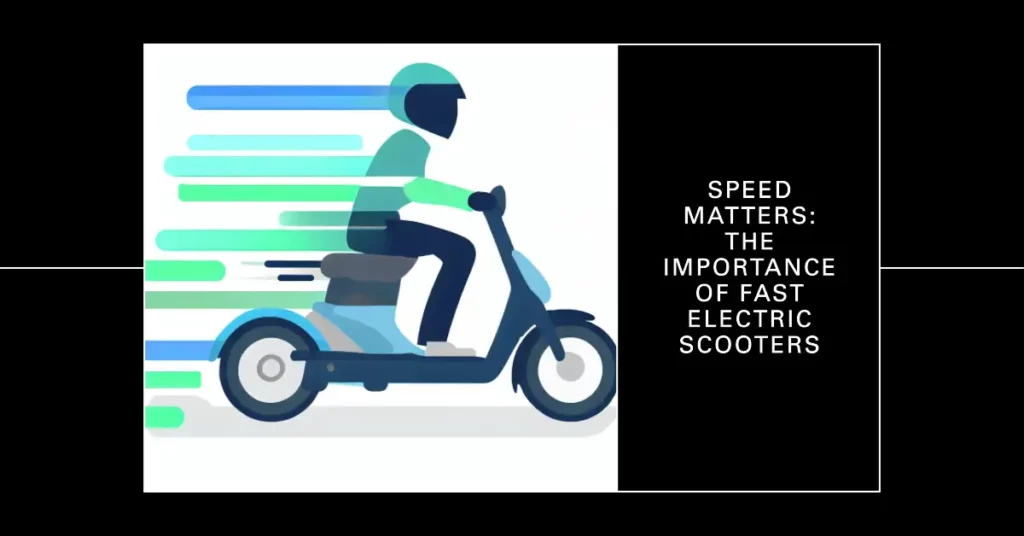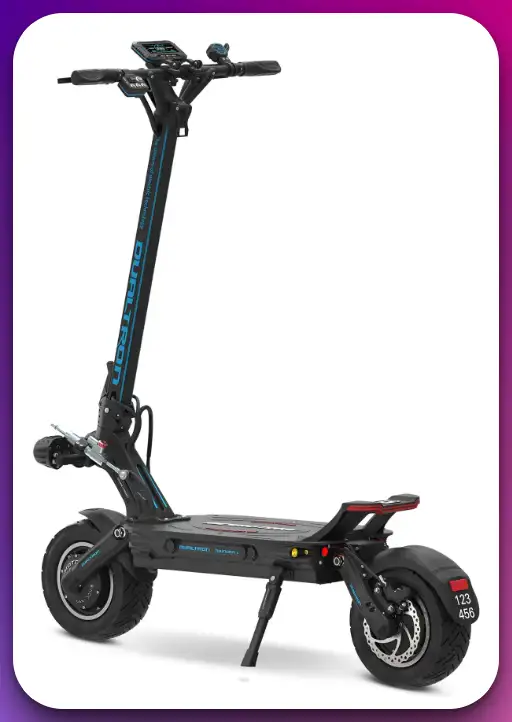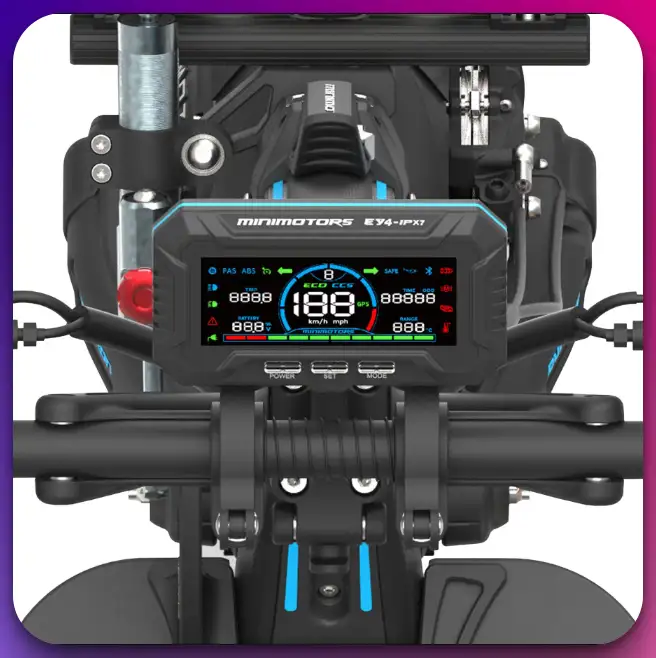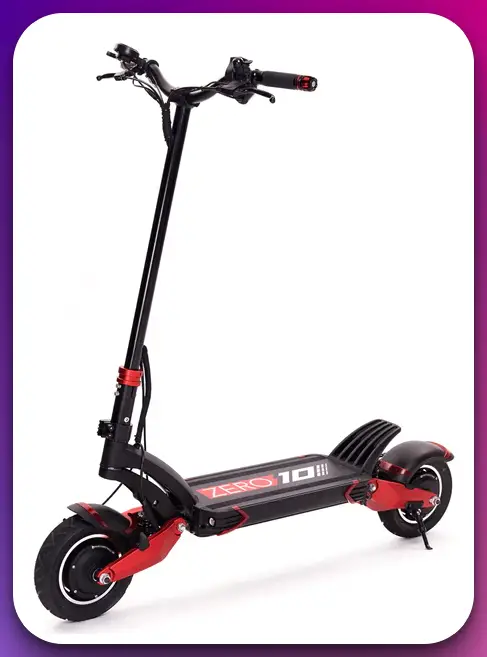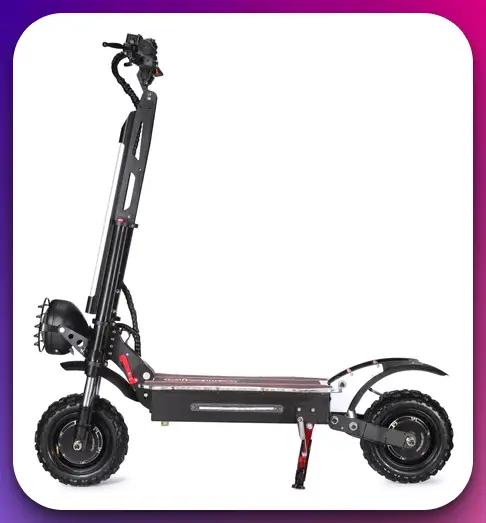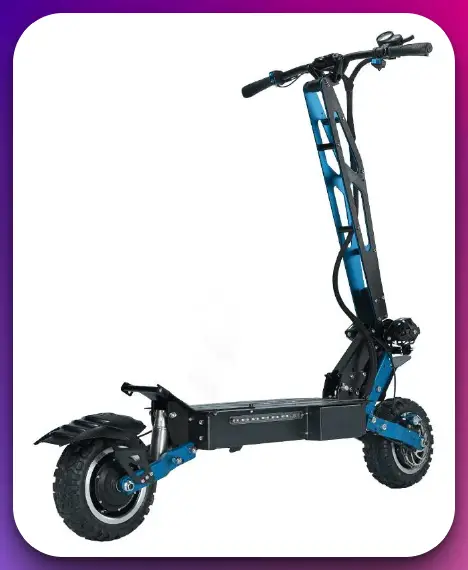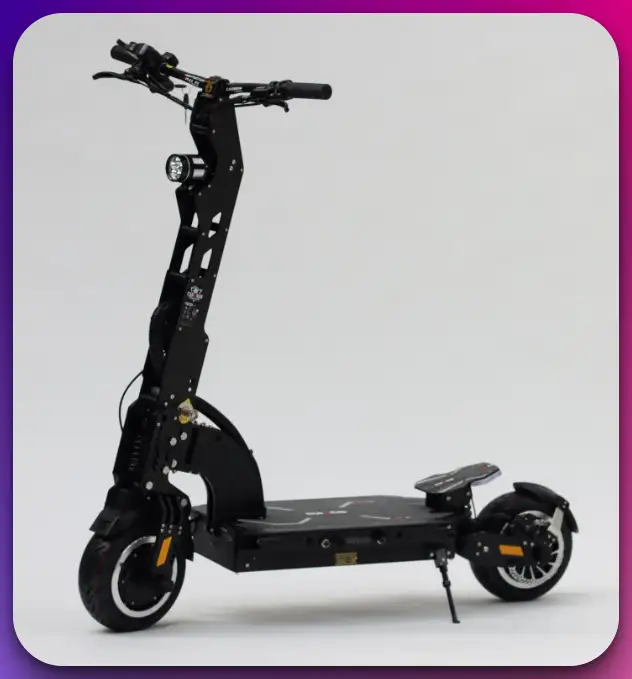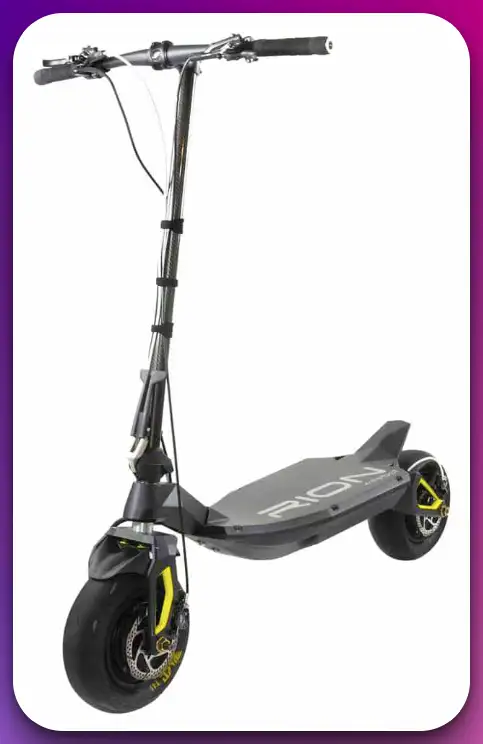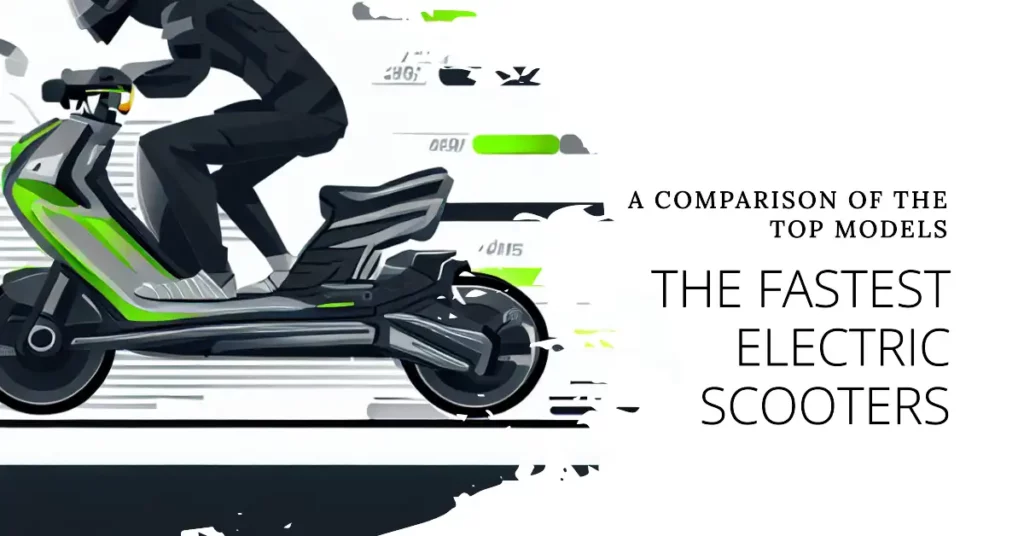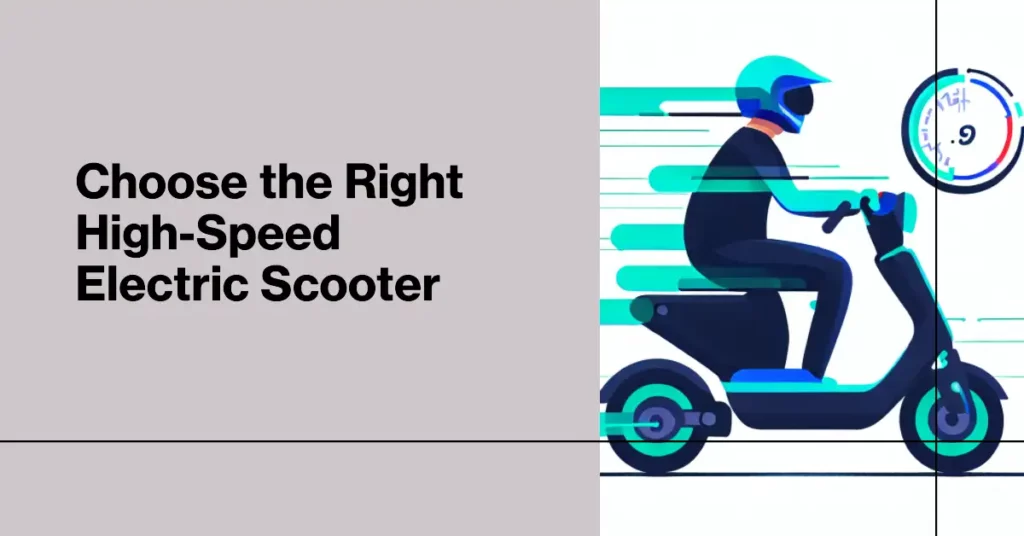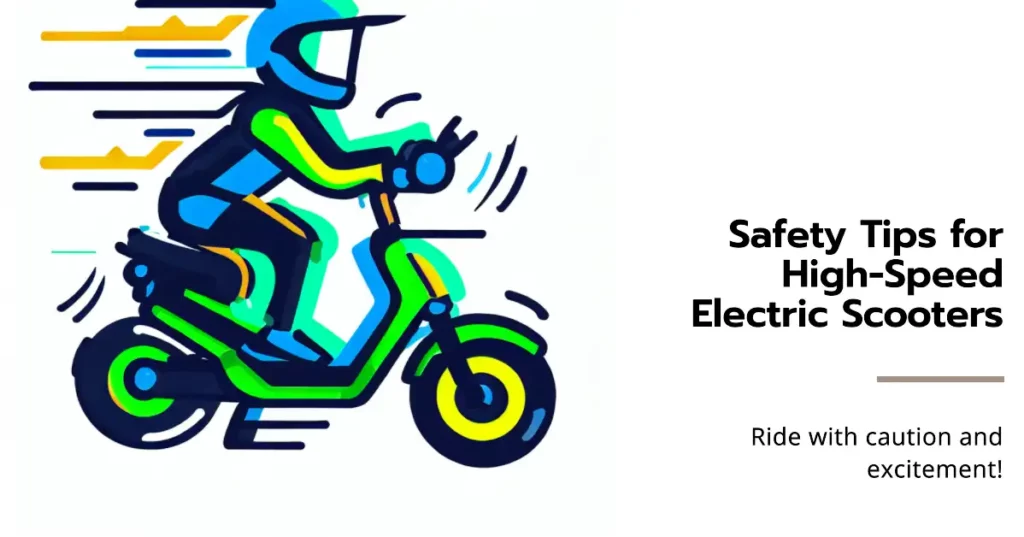Navigating the city’s streets can be arduous, especially during peak hours. Congestion delayed public transportation, and the hassles of finding a parking space are only a few of the struggles commuters face daily.
Traditional modes of transport are often more of a liability than a solution. What if there were a faster, more efficient way to zip through the cityscape that was also eco-friendly and hassle-free?
You’ve probably considered electric scooters as a potential solution. They’re small, convenient, and green. But what about speed?
Does the thought of crawling along bike lanes or sidewalks, watching cyclists whiz by, make you hesitant? You need an electric scooter that doesn’t compromise on speed. You want to feel the thrill of the wind on your face as you effortlessly navigate through urban obstacles.
Here’s the game-changer: the fastest electric scooters on the market. These aren’t your regular electric scooters; they’re high-speed, high-performance machines designed for the modern, urban commuter.
Capable of reaching impressive speeds, these electric scooters offer convenience, efficiency, and an exhilarating ride, all wrapped into one sleek package.
In this article, we’ll introduce you to the world of the fastest electric scooters, discussing their key features, benefits, and how they can revolutionize your daily commute.
Let’s dive into the high-speed world of electric scooters and discover why speed matters.
The Importance of Speed in Electric Scooters
Electric scooters have emerged as a popular and eco-friendly option in the ever-evolving world of personal transportation. As more individuals opt for these sleek machines, speed in electric scooters becomes paramount.
Speed, the rate at which an electric scooter propels itself forward, is a defining factor in the overall user experience.
The significance of speed lies in its ability to enhance efficiency and convenience. With a swifter pace, electric scooters can cover larger distances in shorter timeframes, allowing riders to navigate through bustling city streets or expansive suburban areas with remarkable ease. Moreover, increased speed reduces travel time, making electric scooters a viable alternative for daily commuting.
Beyond practicality, speed injects an element of excitement into the riding experience. The adrenaline rush accompanying accelerated motion adds an extra dimension of enjoyment, especially for thrill-seeking riders.
Electric scooters employ advanced technologies such as high-torque motors, efficient battery systems, and streamlined designs to achieve optimal speed. These components work harmoniously to deliver swift and smooth rides, ensuring riders can reach their destinations swiftly and safely.
However, it is crucial to strike a balance between speed and safety. Manufacturers continuously innovate to implement safety features like responsive braking systems, sturdy frames, and reliable suspension to complement the need for speed without compromising rider well-being.
In conclusion, speed holds immense importance in the realm of electric scooters. Its ability to enhance efficiency, convenience, and overall riding experience solidifies its place as a fundamental aspect of modern personal transportation.
As the technology behind electric scooters continues to evolve, we can anticipate even greater speed potentials, further transforming how we navigate our urban landscapes.
Factors Determining The Speed of an Electric Scooter
When it comes to the speed of an electric scooter, several factors come into play, influencing its performance and overall riding experience. Understanding these determining factors is essential for enthusiasts and potential buyers alike.
Let’s delve into the intricacies of what governs the speed of an electric scooter.
Motor Power:- One of the primary elements dictating speed is the motor’s power. Electric scooters with high-performance motors can generate greater torque, resulting in swift acceleration and higher top speeds.
A robust motor ensures the efficient conversion of electrical energy into mechanical power, propelling the scooter forward with agility.
Battery Capacity:- The battery’s capacity plays a pivotal role in determining the speed and range of an electric scooter. A larger battery capacity means more potential for sustaining increased speeds for extended periods.
Cutting-edge battery technology, such as lithium-ion, offers improved energy density, enabling longer rides at faster speeds.
Weight and Aerodynamics:- The weight of the scooter and its aerodynamic design greatly impact speed. Lighter scooters can achieve higher speeds more easily due to reduced inertia.
Additionally, streamlined designs with features like aerodynamic fairings minimize air resistance, allowing the scooter to glide through the air with minimal drag, further enhancing its speed potential.
Tire Type and Size:- The choice of tires greatly influences both traction and speed. Larger diameter tires, commonly found in high-performance scooters, cover more ground per revolution, contributing to higher speeds. Furthermore, grip-focused tire compounds optimize traction, ensuring stability and control at faster velocities.
Controller and Electronics:- The controller and associated electronics regulate power delivery to the motor. Advanced controllers with sophisticated algorithms can optimize the performance of the electric scooter, allowing for smoother acceleration and potentially higher speeds.
Riders can make informed decisions when choosing their ideal model by considering the factors determining an electric scooter’s speed. It is important to balance power, battery capacity, weight, and other design considerations to find the optimal combination for an exhilarating and enjoyable riding experience.
Top Fastest Electric Scooters – Swift and Furious
1. Dualtron Thunder 3 Electric Scooter – Best Performance
Regarding sheer speed, the Dualtron Thunder 3 Electric Scooter stands head and shoulders above the competition, firmly establishing itself as the epitome of power and velocity in electric scooters.
Designed and engineered by Minimotors, a leading innovator in electric mobility solutions, the Dualtron Thunder 3 reigns supreme as the fastest electric scooter on the market.
With a powerful dual-motor system, this electric scooter delivers an adrenaline-pumping experience. The Dualtron Thunder 3 has two ultra-high-output BLDC motors, each boasting an astonishing peak power of 5400 watts. This exceptional power output enables the Thunder 3 to reach an astounding top speed of up to 50 mph (80 km/h), propelling riders into true exhilaration.
Its cutting-edge technology and premium components make the Thunder 3’s unrivaled speed possible. Its advanced motor controllers ensure precise power delivery, optimizing acceleration and performance for a lightning-fast ride. The scooter’s massive 2072 Wh battery capacity guarantees long-range capabilities while maintaining the capacity to unleash jaw-dropping speeds.
Minimotors has taken meticulous care to ensure rider safety without compromising on speed. The Dualtron Thunder 3 features advanced suspension systems, including front and rear hydraulic brakes, ensuring exceptional control and stability even at high velocities.
The scooter’s wide and durable 11-inch tubeless pneumatic tires provide excellent traction and grip, enabling riders to conquer any terrain confidently.
Moreover, the Thunder 3 boasts an ergonomic design that prioritizes rider comfort. Its adjustable suspension system allows riders to customize their ride experience, tailoring it to their preferences and ensuring a smooth journey even at top speeds.
The scooter’s dual rubber suspension further absorbs shocks and vibrations, guaranteeing a comfortable and stable ride.
In conclusion, the Dualtron Thunder 3 Electric Scooter is not just a mode of transportation but a thrilling adventure waiting to unfold. Its unrivaled speed capabilities and exceptional engineering and safety features position it as the pinnacle of electric scooter technology.
For those seeking the ultimate rush and an unparalleled riding experience, the Dualtron Thunder 3 is undoubtedly the fastest electric scooter that will leave you breathless and craving more.
Check out the official website here to explore the Thunder 3 and embark on your journey towards electrifying speed.
Key Features:-
Unrivaled Speed: The Dualtron Thunder 3 boasts the title of the fastest electric scooter on the market, reaching top speeds of up to 50 mph (80 km/h), providing an exhilarating ride experience.
Powerful Dual Motor System: Equipped with two ultra-high-output BLDC motors, each with a peak power of 5400 watts, the Thunder 3 delivers exceptional acceleration and performance, allowing riders to tackle steep inclines and challenging terrains with ease.
Long-Range Capabilities: The Thunder 3 features a massive 2072 Wh battery capacity, providing riders with an impressive range, ensuring they can enjoy extended rides without worrying about running out of power.
Advanced Suspension System: With its adjustable and dual rubber suspension system, the Thunder 3 offers excellent shock absorption and a smooth ride even on rough surfaces, enhancing overall comfort and stability.
Superior Braking System: The Thunder 3 has front and rear hydraulic brakes, ensuring reliable and responsive stopping power and enabling riders to maintain control and safety at high speeds.
Durable and Wide Tires: The 11-inch tubeless pneumatic tires provide exceptional traction and stability, allowing riders to confidently navigate various terrains, including uneven surfaces and urban environments.
Ergonomic Design: The Thunder 3 features an ergonomic design with adjustable handlebars and a comfortable riding position, allowing riders to find their preferred posture and enjoy a customized riding experience.
Integrated Lighting System: The Thunder 3 has built-in front and rear LED lights, enhancing visibility and ensuring safety during night rides or in low-light conditions.
Advanced Display and Controls: The scooter features a clear and informative display panel, providing essential ride information such as speed, battery level, and more. The intuitive controls make it easy to navigate through different settings and modes.
Robust Construction: The Thunder 3 is built with high-quality materials and a sturdy frame, ensuring durability and longevity, making it suitable for everyday commuting and adventurous off-road adventures.
The Dualtron Thunder 3 Electric Scooter combines unrivaled speed, powerful performance, and advanced features, making it an exceptional choice for riders seeking a thrilling and high-performance electric scooter. Its long-range capabilities, superior suspension and braking systems, and ergonomic design contribute to an exceptional riding experience.
Pros:-
Unmatched Speed: The Dualtron Thunder 3 holds the crown as the fastest electric scooter available, reaching up to 50 mph (80 km/h), providing an exhilarating ride for adrenaline junkies.
Powerful Dual Motor System: With its dual ultra-high-output BLDC motors, each boasting a peak power of 5400 watts, the Thunder 3 delivers exceptional acceleration and performance, allowing riders to conquer any terrain with ease.
Long-Range Capabilities: Equipped with a massive 2072 Wh battery capacity, the Thunder 3 provides ample power for extended rides, ensuring you can go the distance without worrying about running out of charge.
Advanced Suspension and Braking: The Thunder 3 features an advanced suspension system, including front and rear hydraulic brakes, offering superior control, stability, and safety even at high speeds. The wide and durable 11-inch tubeless pneumatic tires provide excellent traction and grip.
Customizable Ride Experience: The adjustable suspension system of the Thunder 3 allows riders to personalize their ride, tailoring it to their preferences and ensuring a comfortable and smooth journey regardless of the terrain.
Cons:-
High Price Point: The Thunder 3’s exceptional performance and advanced features come at a higher cost than other electric scooters on the market, making it a significant investment for potential buyers.
Heavier Weight: The Thunder 3 is relatively heavy compared to other electric scooters due to its robust construction and powerful components. This may impact portability and maneuverability for some users.
Restricted Legality: The high speed of the Thunder 3 may exceed legal limits in certain jurisdictions, making it unsuitable for riders in areas with strict regulations on electric scooter speeds. Always ensure compliance with local laws and regulations.
Limited Availability: The Thunder 3 may not be readily available in all regions, potentially limiting accessibility for interested buyers residing in areas with limited distribution.
While the Dualtron Thunder 3 Electric Scooter offers unparalleled speed, power, and advanced features, potential buyers must consider their specific needs, budget, and local regulations before purchasing.
2. WOLF WARRIOR 11 PRO +
Experience speed and power with the WOLF WARRIOR 11 PRO+—a true marvel in electric scooters. Proudly presented by Kaabo, a renowned name in electric mobility solutions, the WOLF WARRIOR 11 PRO+ stands tall as the fastest electric scooter that will ignite your passion for extreme performance and adrenaline-fueled adventures.
Equipped with a high-speed 5400W dual motor system, the WOLF WARRIOR 11 PRO+ propels riders to unimaginable velocities. Unleash the beast within as this extraordinary scooter conquers the roads and off-road terrains, reaching an astounding top speed of up to 50 mph (80 km/h), leaving everything else in its dust.
The WOLF WARRIOR 11 PRO+ is designed for those seeking an extraordinary experience. With its massive 72V 35Ah LG lithium-ion battery, this electric scooter delivers exceptional range capabilities, allowing you to embark on thrilling journeys without worrying about running out of power.
Safety is paramount, even at high speeds. The WOLF WARRIOR 11 PRO+ ensures optimal control and stability with its advanced front and rear hydraulic suspension system.
Tackle challenging terrains effortlessly, thanks to the scooter’s 11-inch off-road tires, providing exceptional grip and traction. At the same time, the sturdy frame and dual hydraulic brakes offer reliable stopping power when you need it most.
The WOLF WARRIOR 11 PRO+ is not just about speed; it’s a masterpiece of engineering and design. Its ergonomic, adjustable handlebars and comfortable and spacious deck allow riders to find their ideal riding position for long-lasting comfort and confidence.
Unleash the true potential of the WOLF WARRIOR 11 PRO+ with its advanced display system that provides real-time information such as speed, battery life, and more. Navigate effortlessly through different modes and settings, enhancing your riding experience.
In conclusion, the WOLF WARRIOR 11 PRO+ is not just a scooter—it’s a statement of power and performance. With its exceptional speed, long-range capabilities, advanced suspension system, and sturdy construction, this electric scooter is a force to be reckoned with.
Embrace the thrill of speed, embark on daring adventures, and conquer new horizons with the WOLF WARRIOR 11 PRO+—the fastest electric scooter that will leave you exhilarated and craving more.
Visit the official website here to discover the extraordinary WOLF WARRIOR 11 PRO+.
Key Features:-
Unmatched Speed: The WOLF WARRIOR 11 PRO+ stands out as the fastest electric scooter, reaching up to 50 mph (80 km/h), and delivering an adrenaline-pumping ride experience.
Powerful Dual Motor System: Equipped with a high-speed 5400W dual motor system, this scooter offers exceptional acceleration and performance, allowing riders to conquer various terrains easily.
Extended Range: The WOLF WARRIOR 11 PRO+ features a large 72V 35Ah LG lithium-ion battery, providing ample power and an impressive range to embark on long-distance rides without worrying about running out of charge.
Advanced Suspension System: Designed for off-road adventures, the scooter has a front and rear hydraulic suspension system, ensuring superior shock absorption and stability, even on rough and uneven surfaces.
Durable Off-Road Tires: The 11-inch off-road tires of the WOLF WARRIOR 11 PRO+ offer excellent traction and grip, enabling riders to confidently navigate various terrains, including gravel, dirt, and grass.
Dual Hydraulic Brakes: With reliable dual hydraulic brakes, the scooter provides responsive and powerful stopping capabilities, enhancing safety and control at high speeds.
Ergonomic Design: The WOLF WARRIOR 11 PRO+ is designed for rider comfort. It’s adjustable handlebars and spacious deck allow riders to find their ideal riding position, ensuring a comfortable and customized experience.
Advanced Display System: The scooter features an intuitive and informative display system that provides real-time information, including speed, battery life, distance traveled, and more, allowing riders to stay informed during their journeys.
Sturdy Construction: Built with a robust frame and high-quality materials, the WOLF WARRIOR 11 PRO+ ensures durability and reliability, making it suitable for urban commuting and adventurous off-road riding.
Integrated Lighting System: The scooter has front and rear LED lights, enhancing visibility and safety during nighttime rides or in low-light conditions.
The WOLF WARRIOR 11 PRO+ electric scooter combines exceptional speed, power, and advanced features, making it an ideal choice for riders seeking a thrilling, high-performance experience. Its extended range, advanced suspension, durable tires, and ergonomic design offer both exhilarating rides and comfortable journeys.
Pros:-
Impressive Speed: The WOLF WARRIOR 11 PRO+ is renowned for its remarkable top speed of up to 50 mph (80 km/h), offering an exhilarating and adrenaline-filled riding experience.
Powerful Dual Motor System: With its high-speed 5400W dual motor system, this scooter delivers exceptional acceleration and performance, allowing riders to tackle steep hills and challenging terrains easily.
Long-Range Capabilities: Equipped with a large 72V 35Ah LG lithium-ion battery, the WOLF WARRIOR 11 PRO+ provides ample power for extended rides, enabling riders to cover significant distances without worrying about running out of charge.
Off-Road Capability: Designed for off-road adventures, this scooter features an advanced suspension system and 11-inch off-road tires, ensuring superior shock absorption, stability, and excellent traction on various terrains.
Reliable Braking System: The WOLF WARRIOR 11 PRO+ has dual hydraulic brakes, providing responsive and powerful stopping capabilities and enhancing safety and control, especially at high speeds.
Comfortable Riding Experience: With its adjustable handlebars and spacious deck, this scooter offers a comfortable riding position and customization options to suit different rider preferences.
Cons:-
Higher Price Point: The advanced features and superior performance of the WOLF WARRIOR 11 PRO+ come at a higher price than other electric scooters on the market, making it a significant investment for some riders.
Heavyweight and Size: Due to its robust construction and powerful components, the scooter is relatively heavy and bulky, which may impact portability and maneuverability for some users.
Restricted Legality: The high speeds achieved by the WOLF WARRIOR 11 PRO+ may exceed legal limits in certain areas, making it unsuitable for riders in regions with strict regulations on electric scooter speeds. Always ensure compliance with local laws and regulations.
Limited Availability: The WOLF WARRIOR 11 PRO+ may not be readily available in all regions, which could limit accessibility for interested buyers.
While the WOLF WARRIOR 11 PRO+ electric scooter offers impressive speed, power, and advanced features, potential buyers should consider their needs, budget, and local regulations before purchasing. It is essential to weigh the pros and cons to determine if this scooter aligns with your riding preferences and requirements.
3. Apollo Pro (60V)
Introducing the Apollo Pro (60V) electric scooter—an embodiment of speed and power that catapults riders into electrifying velocity. Developed by Apollo Scooters, a pioneer in the electric mobility industry, the Apollo Pro (60V) stands tall as the epitome of the fastest electric scooter available, offering an exhilarating and dynamic ride experience.
Equipped with a high-performance 60V motor, the Apollo Pro delivers an unrivaled power surge. Prepare to be amazed as this electric scooter propels you to extraordinary speeds, leaving a trail of excitement in its wake.
With its unparalleled acceleration and top speed, the Apollo Pro (60V) offers a thrilling adventure for speed enthusiasts and thrill-seekers.
Designed for optimum performance, the Apollo Pro (60V) boasts a high-capacity battery that provides substantial energy for extended rides. This impressive power source ensures that you can venture farther, pushing the limits of exploration without worrying about battery depletion.
Safety is of paramount importance, even at breakneck speeds. The Apollo Pro (60V) features a robust suspension system that mitigates bumps and vibrations, delivering a smooth and comfortable ride. The dual hydraulic disc brakes offer exceptional stopping power, ensuring precise control and reliable safety.
Crafted with precision and attention to detail, the Apollo Pro (60V) combines style and practicality. The scooter’s sleek design, complemented by quality components and premium finishes, elevates the riding experience.
The Apollo Pro (60V) is not just about speed—it’s a testament to advanced engineering and innovation. Its intuitive display provides essential ride information, including speed, battery life, and distance traveled, keeping you informed throughout your journey.
With its foldable design, the Apollo Pro (60V) offers convenience and portability, allowing for easy storage and transportation.
In conclusion, the Apollo Pro (60V) is the pinnacle of speed and performance in the electric scooter market. Its remarkable acceleration, high-capacity battery, advanced suspension, and sleek design make it a force to be reckoned with.
Brace yourself for an electrifying experience as you unleash the power of the Apollo Pro (60V), the fastest electric scooter that promises an adrenaline-fueled journey into the world of speed.
Visit the official website here to embark on your thrilling ride with the Apollo Pro (60V).
Key Features:-
Lightning Speed: The Apollo Pro (60V) is known for its exceptional speed, providing riders with an exhilarating experience as they reach impressive velocities on the road.
High-Performance 60V Motor: Equipped with a powerful 60V motor, this electric scooter delivers remarkable acceleration and performance, allowing riders to experience thrilling rides easily.
Long-Lasting Battery: The Apollo Pro (60V) features a high-capacity battery that provides ample energy for extended rides, ensuring riders can enjoy longer distances without worrying about running out of power.
Advanced Suspension System: Designed to offer a smooth and comfortable ride, the Apollo Pro (60V) has a robust suspension system that absorbs shocks and vibrations, making it suitable for various terrains and minimizing rider fatigue.
Dual Hydraulic Disc Brakes: Safety is a top priority, and the Apollo Pro (60V) ensures precise control and reliable stopping power with its dual hydraulic disc brakes, allowing riders to have confidence in their ability to bring the scooter to a halt when needed.
Sleek and Stylish Design: Combining aesthetics with functionality, the Apollo Pro (60V) boasts a sleek design that turns heads and enhances the overall riding experience.
Intuitive Display: The scooter’s intuitive display provides riders with essential ride information, including speed, battery life, and distance traveled, allowing for convenient monitoring and ensuring an informed riding experience.
Foldable and Portable: The Apollo Pro (60V) features a foldable design that enhances convenience and portability. It can be easily stored and transported, making it a practical choice for commuters and those constantly on the go.
Premium Quality: Crafted with attention to detail and quality components, the Apollo Pro (60V) exudes durability and reliability, ensuring a long-lasting and enjoyable ownership experience.
The Apollo Pro (60V) electric scooter combines lightning speed, powerful performance, and advanced features, making it an ideal choice for electrifying and high-performance ride riders.
With its long-lasting battery, advanced suspension system, intuitive display, and sleek design, the Apollo Pro (60V) offers a thrilling and stylish transportation solution.
Pros:-
Impressive Speed: The Apollo Pro (60V) offers exceptional speed, providing riders with an exhilarating experience and the ability to reach their destinations quickly.
Powerful Motor: Equipped with a high-performance 60V motor, this scooter delivers strong acceleration and performance, allowing riders to navigate various terrains easily.
Long-Lasting Battery: The Apollo Pro (60V) features a high-capacity battery that offers extended ride times, enabling riders to cover longer distances without worrying about running out of power.
Advanced Suspension System: With its robust suspension system, the Apollo Pro (60V) provides a smooth and comfortable ride, effectively absorbing shocks and vibrations, even on uneven surfaces.
Dual Hydraulic Disc Brakes: The scooter’s dual hydraulic disc brakes ensure reliable and responsive braking, providing riders with enhanced safety and control.
Stylish Design: The Apollo Pro (60V) showcases a sleek, attractive design that looks appealing and enhances the riding experience.
Cons:-
Higher Price Point: The advanced features and performance of the Apollo Pro (60V) may come at a higher price than some other electric scooters, making it less accessible for budget-conscious buyers.
Weight and Portability: The scooter’s sturdy construction and powerful components contribute to its weight, making it less convenient for some riders to carry or transport.
Limited Availability: Depending on the region, the Apollo Pro (60V) may not be readily available, which could limit accessibility for potential buyers in certain areas.
While the Apollo Pro (60V) electric scooter offers impressive speed, powerful performance, and a stylish design, potential buyers must consider their needs, budget, and preferences before purchasing.
Understanding the pros and cons can help determine if this scooter aligns with their requirements and enhances their riding experience.
4. Zero 10X – Best Value for Money
Welcome to the world of electric mobility, where the Zero 10X electric scooter reigns supreme as a powerhouse of performance and versatility. Developed by Zero Electric Scooter, a leading brand in the industry, the Zero 10X stands tall as a symbol of power, efficiency, and unrivaled capability.
With its striking design and robust construction, the Zero 10X grabs attention wherever it goes. But it’s not just about appearances—the real magic lies within.
Equipped with a dual motor system, this scooter delivers an impressive burst of power, allowing riders to tackle challenging terrains and conquer steep inclines easily.
The Zero 10X is engineered to provide a smooth and exhilarating ride. Its powerful motors generate remarkable torque, resulting in swift acceleration and a thrilling riding experience. Feel the rush as you effortlessly reach impressive speeds that will leave you breathless.
What sets the Zero 10X apart is its adaptability. This scooter is built to handle various environments, from city streets to off-road trails. The dual suspension system provides excellent shock absorption, ensuring a comfortable ride even on bumpy surfaces.
Coupled with its wide and sturdy tires, the Zero 10X offers superior traction and stability, instilling confidence in riders regardless of the terrain.
Safety is paramount, and the Zero 10X takes it seriously. It has responsive disc brakes that provide reliable stopping power, allowing riders to maintain control even at high speeds. The scooter’s bright LED lights enhance visibility during nighttime rides, promoting safety on the road.
While power and performance are the hallmarks of the Zero 10X, it also offers convenience and practicality. With its foldable design and compact form, the scooter is easily transportable, fitting seamlessly into your daily routine.
In conclusion, the Zero 10X represents a new era of electric scooters, embodying power, versatility, and uncompromising performance. Whether you seek an exhilarating ride or a reliable mode of transportation, the Zero 10X delivers on all fronts. Experience the thrill of the Zero 10X and embark on your electric adventure today.
Visit the official website here to explore the incredible features of the Zero 10X.
Key Features:-
Dual Motor System: The Zero 10X has a powerful dual motor system that delivers impressive acceleration and performance, allowing riders to conquer challenging terrains easily.
High Speed: With its powerful motors, the Zero 10X can reach remarkable speeds, providing an exhilarating riding experience that satisfies speed enthusiasts.
Versatile Terrain Capability: Designed for versatility, the Zero 10X is suitable for both urban environments and off-road adventures. Its sturdy construction, wide tires, and dual suspension system enable riders to tackle various terrains confidently.
Dual Suspension System: The scooter features a dual suspension system that absorbs shocks and vibrations, ensuring a comfortable ride on uneven surfaces and enhanced stability and control.
Responsive Disc Brakes: The Zero 10X has responsive disc brakes that offer reliable stopping power, enabling riders to maintain control and ensure safety during their rides.
Bright LED Lights: The scooter has bright LED lights, including headlights and taillights, improving visibility and promoting safety, especially during nighttime rides.
Foldable Design: The Zero 10X features a foldable design, allowing for easy storage and transportation. This makes it convenient for riders who need to carry or store their scooter in compact spaces.
Long Battery Life: With its high-capacity battery, the Zero 10X provides a long-lasting ride, allowing riders to cover significant distances without worrying about running out of power.
Comfortable Riding Experience: The scooter’s ergonomic design, adjustable handlebars, and spacious deck provide a comfortable riding experience, accommodating riders of different heights and preferences.
Durable Build: The Zero 10X is built with durability in mind, using high-quality materials and components to ensure longevity and reliability.
The Zero 10X electric scooter combines power, versatility, and a range of features that enhance the riding experience. Its dual motor system, high speed, adaptable terrain capability, dual suspension, and responsive brakes suit various riding preferences and environments. The foldable design, long battery life, and comfortable features add convenience and practicality to the package.
Pros:-
Powerful Performance: The Zero 10X boasts a dual motor system and high-speed capabilities, providing riders with impressive acceleration and exhilarating rides.
Versatile Terrain Adaptability: With its sturdy construction, wide tires, and dual suspension system, the Zero 10X is suitable for urban and off-road terrains, allowing riders to explore various environments.
Comfortable Ride: The dual suspension system and ergonomic design of the Zero 10X ensure a comfortable and smooth riding experience, even on uneven surfaces.
Responsive Brakes: Equipped with responsive disc brakes, the Zero 10X offers reliable stopping power and enhanced control, promoting rider safety.
Long Battery Life: The Zero 10X features a high-capacity battery that provides a long-lasting ride, allowing riders to cover significant distances before recharging.
Foldable Design: The scooter’s foldable design allows for easy storage and transportation, making it convenient for riders on the go.
Cons:-
Weight and Portability: The robust construction and powerful components of the Zero 10X contribute to its weight, which may make it less portable or challenging to carry for some riders.
Limited Availability: Depending on the region, the Zero 10X may have limited availability, making it less accessible to potential buyers in certain areas.
Higher Price Range: The advanced features and performance of the Zero 10X may come at a higher price than some other electric scooters on the market, which could be a limiting factor for budget-conscious buyers.
While the Zero 10X electric scooter offers powerful performance, versatile terrain adaptability, and a comfortable ride, potential buyers must consider their specific needs, budget, and preferences. Weighing the pros and cons will help determine if the Zero 10X aligns with their requirements and provides an optimal riding experience.
5. Qiewa Q Power 2
Welcome to the world of electrifying mobility with the Qiewa Q Power 2 electric scooter.
Crafted to perfection, the Q Power 2 is a testament to power, endurance, and exceptional performance. Designed by Qiewa, a leading name in the industry, this scooter delivers an extraordinary ride experience that surpasses expectations.
The Qiewa Q Power 2 packs a punch, featuring a robust motor and cutting-edge engineering. Its powerful motor generates immense torque and propels riders forward with impressive acceleration. Prepare to experience the thrill of speed as you unleash the Q Power 2’s capability.
But it’s not just about speed; the Q Power 2 also excels in endurance. Equipped with a high-capacity 26Ah lithium-ion battery, this scooter provides an impressive range that allows riders to venture farther. Say goodbye to range anxiety and embrace the freedom to explore.
The Q Power 2 is built to conquer diverse terrains. Its durable construction ensures reliability, while the heavy-duty suspension system absorbs shocks and vibrations, providing a smooth and comfortable ride even on rough surfaces.
With its all-terrain tires, the Q Power 2 delivers superior traction and stability, enabling riders to tackle various environments confidently.
Safety is paramount, and the Q Power 2 doesn’t compromise. It features a triple braking system that includes front and rear disc brakes and an electronic brake, ensuring reliable stopping power and precise control. Ride with confidence, knowing that your safety is prioritized.
Beyond its performance and endurance, the Q Power 2 offers convenience and practicality. Its foldable design allows for easy storage and transportation, making it ideal for commuters and those on the go. The scooter’s LED headlight and taillight enhance visibility, ensuring safety during nighttime rides.
In conclusion, the Qiewa Q Power 2 electric scooter represents the pinnacle of power, endurance, and reliability. With its impressive motor, long-range capabilities, durable construction, and advanced safety features, this scooter is a force to be reckoned with. Experience the thrill of the Q Power 2 and redefine your ride.
Visit the official website here to embark on your electrifying journey with the Qiewa Q Power 2.
Key Features:-
Powerful Motor: The Qiewa Q Power 2 has a robust motor that delivers impressive acceleration and performance, allowing riders to experience the thrill of speed.
Long-Lasting Battery: With its high-capacity 26Ah lithium-ion battery, the Q Power 2 provides an extended range, enabling riders to cover significant distances on a single charge.
Endurance and Reliability: The scooter’s durable construction ensures reliability, allowing it to withstand the demands of various terrains and riding conditions.
All-Terrain Capability: The Q Power 2 is designed to handle different terrains easily. Its all-terrain tires provide excellent traction and stability, allowing riders to navigate rough surfaces, gravel, and uneven terrain confidently.
Heavy-Duty Suspension: The scooter features a heavy-duty suspension system that absorbs shocks and vibrations, providing a smooth and comfortable ride even on bumpy roads or off-road trails.
Triple Braking System: Safety is a priority, and the Q Power 2 incorporates a triple braking system consisting of front and rear disc brakes and an electronic brake, ensuring reliable stopping power and precise control.
Foldable Design: The Q Power 2 features a foldable design for easy storage and transportation. It is convenient for commuters and riders carrying or storing their scooter in compact spaces.
LED Headlight and Taillight: The scooter has a bright LED headlight and taillight, enhancing visibility and promoting safety during nighttime rides or in low-light conditions.
Ergonomic Design: The Q Power 2 prioritizes rider comfort with its ergonomic design. It features adjustable handlebars and a spacious deck, allowing riders to find their optimal riding position.
Convenient Accessories: The scooter may come with convenient accessories such as a phone holder, USB charging port, or storage compartments, enhancing the user experience.
The Qiewa Q Power 2 electric scooter combines powerful performance, long-range capabilities, and durability. Its all-terrain capability, heavy-duty suspension, triple braking system, and foldable design suit various riding environments and commuting needs. The scooter’s ergonomic design and additional accessories further enhance convenience and comfort.
Pros:-
Powerful Performance: The Q Power 2 offers a powerful motor and impressive acceleration, giving riders a thrilling ride experience.
Long Range: With its high-capacity battery, the Q Power 2 provides a long-lasting ride, allowing riders to cover significant distances without frequent recharging.
Durable Construction: The sturdy and durable scooter ensures reliability and longevity, making it suitable for various terrains and riding conditions.
All-Terrain Capability: Equipped with all-terrain tires and a heavy-duty suspension system, the Q Power 2 can handle different terrains, providing riders stability and control even on rough surfaces.
Triple Braking System: The scooter’s triple braking system, including front and rear disc brakes and an electronic brake, ensures reliable and responsive stopping power, enhancing rider safety.
Foldable Design: The Q Power 2 features a foldable design, allowing for easy storage and transportation, making it convenient for commuters and riders with limited storage space.
Cons:-
Weight and Portability: The Q Power 2 is relatively heavy due to its durable construction and powerful components, which may make it less portable for some riders.
Limited Availability: Depending on the region, the Q Power 2 may have limited availability, which could constrain potential buyers in certain areas.
Higher Price Range: The advanced features and performance of the Q Power 2 may come at a higher price point than some other electric scooters on the market, making it less accessible for budget-conscious buyers.
While the Qiewa Q Power 2 electric scooter offers powerful performance, long-range durability, and off-road capabilities, potential buyers must consider their specific needs, budget, and preferences. Weighing the pros and cons will help determine if the Q Power 2 aligns with their requirements and provides an optimal riding experience.
6. NanRobot RS7
Prepare yourself for the ultimate ride experience with the NanRobot RS7 electric scooter. Designed for thrill-seekers and performance enthusiasts, the NanRobot RS7 combines power, speed, and style in a single electrifying package.
With its cutting-edge design and sleek aesthetics, the NanRobot RS7 is a head-turner. But its beauty is more than skin deep.
This scooter has a high-powered dual-motor system that delivers jaw-dropping acceleration and performance. Feel the rush as you unleash the full potential of the NanRobot RS7 and soar to remarkable speeds.
But the NanRobot RS7 isn’t just about speed—it’s about control too. The scooter features a high-quality suspension system that absorbs shocks and vibrations, providing a smooth and comfortable ride even on rough terrain. Its large, sturdy tires offer excellent traction and stability, ensuring confident handling and control at high speeds.
Equipped with a long-lasting battery, the NanRobot RS7 provides an extended range that allows riders to explore more without worrying about running out of power. Say goodbye to range anxiety and embrace the freedom to embark on longer journeys.
Safety is a top priority for NanRobot, and the RS7 doesn’t disappoint. It has a dual braking system, including front and rear disc brakes, ensuring responsive and reliable stopping power when needed.
The scooter’s bright LED lights enhance visibility and promote safety during nighttime rides or in low-light conditions.
Designed with rider comfort in mind, the NanRobot RS7 features an ergonomic design with an adjustable handlebar and a spacious deck, providing a comfortable and customized riding experience. Whether commuting or embarking on an adventurous joyride, the NanRobot RS7 keeps you comfortable and in control.
In conclusion, the NanRobot RS7 is a true performance machine, delivering power, speed, and style in one thrilling package.
With its dual motor system, advanced suspension, long-lasting battery, and safety features, this electric scooter is a game-changer in the industry. Experience the exhilaration of the NanRobot RS7 and elevate your ride to new heights.
Visit the official website here to embark on your electrifying journey with the NanRobot RS7.
Key Features:-
Powerful Dual Motor System: The NanRobot RS7 has a high-powered dual motor system that delivers impressive acceleration and performance, allowing riders to experience exhilarating speeds.
Sleek and Stylish Design: The RS7 boasts a cutting-edge design and sleek aesthetics, making it an eye-catching and stylish electric scooter.
Advanced Suspension System: Its high-quality suspension system, the NanRobot RS7, absorbs shocks and vibrations, ensuring a smooth and comfortable ride even on uneven or rough terrains.
Large, Sturdy Tires: The scooter features large, sturdy tires that provide excellent traction and stability, enhancing control and maneuverability at high speeds.
Long-Lasting Battery: Equipped with a long-lasting battery, the NanRobot RS7 offers an extended range, allowing riders to go on longer journeys without worrying about running out of power.
Dual Braking System: The RS7 has a dual braking system, including front and rear disc brakes, ensuring responsive and reliable stopping power for enhanced safety and control.
Bright LED Lights: The scooter has bright LED lights, including headlights and taillights, which improve visibility and promote safety during nighttime rides or in low-light conditions.
Ergonomic Design: The NanRobot RS7 features an ergonomic design with an adjustable handlebar and a spacious deck, providing riders with comfort and customization for their preferred riding position.
Foldable and Portable: The scooter’s foldable design allows for easy storage and transportation, making it convenient for commuters and riders who need to carry it on public transportation or store it in limited spaces.
High-Quality Construction: The NanRobot RS7 is built with high-quality materials and components, ensuring durability and reliability for long-term use. The NanRobot RS7 electric scooter offers powerful performance, a sleek design, and a range of features that enhance the riding experience.
Its dual motor system, advanced suspension, long-lasting battery, and safety features make it a versatile and exciting option for riders. The scooter’s ergonomic design, foldability, and high-quality construction enhance its appeal and practicality.
Pros:-
Powerful Performance: The NanRobot RS7 offers a high-powered dual motor system, delivering impressive acceleration and performance, providing riders with an exhilarating ride experience.
Sleek and Stylish Design: The RS7 features a sleek and stylish design that turns heads and adds a touch of sophistication to your ride.
Advanced Suspension System: With its high-quality suspension system, the NanRobot RS7 ensures a smooth and comfortable ride, even on uneven terrains, reducing the impact of bumps and vibrations.
Long Range: Equipped with a long-lasting battery, the RS7 provides an extended range, allowing riders to cover significant distances without worrying about running out of power.
Dual Braking System: The scooter’s dual braking system, with front and rear disc brakes, offers responsive and reliable stopping power, enhancing safety and control.
Bright LED Lights: The NanRobot RS7 has bright LED lights, including headlights and taillights, improving visibility during nighttime rides and increasing overall safety.
Cons:-
Weight and Portability: Due to its powerful motor and sturdy construction, the RS7 may be relatively heavy, making it less portable and challenging to carry for some riders.
Limited Availability: Depending on the region, the NanRobot RS7 may have limited availability, which could constrain potential buyers in certain areas.
Higher Price Range: The advanced features and performance of the RS7 may come at a higher price point than some other electric scooters on the market, which could be a limiting factor for budget-conscious buyers.
While the NanRobot RS7 electric scooter offers powerful performance, sleek design, advanced suspension, and long-range, potential buyers must consider their specific needs, preferences, and budget. Assessing the pros and cons will help determine if the NanRobot RS7 aligns with their requirements and provides an optimal riding experience.
7. Currus Panther – Best Features
Welcome to the realm of electrifying mobility with the Currus Panther electric scooter. Crafted with precision and designed for performance, the Currus Panther symbolizes power, style, and exceptional ride quality.
Developed by Currus Electric Scooters, a renowned name in the industry, this scooter delivers an extraordinary riding experience that surpasses expectations. Featuring a powerful motor and state-of-the-art engineering, the Currus Panther unleashes unrivaled power that propels riders forward with exhilarating acceleration.
Brace yourself as you experience the rush of speed and the thrill of effortless performance, courtesy of the Currus Panther.
But it’s not just about power—the Currus Panther is a true beauty. With its sleek and captivating design, this scooter turns heads wherever it goes. Its attention to detail and premium finishes elevate the aesthetics, making it stand out.
Safety is paramount, and the Currus Panther leaves no room for compromise. It has a dual hydraulic braking system that ensures precise control and reliable stopping power. The scooter’s bright LED headlights enhance visibility, allowing for safe rides even in low-light conditions.
The Currus Panther is designed to offer a smooth and comfortable ride. Its advanced front and rear suspension system absorbs shocks and vibrations, providing optimal comfort and stability. Cruise through city streets or easily navigate uneven terrains as the Currus Panther tackles every obstacle effortlessly.
With its long-lasting battery, the Currus Panther offers an extended range, allowing riders to explore more without worrying about running out of power. Embrace the freedom to embark on longer journeys and experience the joy of unlimited exploration.
In conclusion, the Currus Panther is a fusion of power, style, and cutting-edge technology. Its powerful motor, captivating design, advanced safety features, and comfortable ride make it a top choice for riders seeking an electrifying experience. Experience the thrill of the Currus Panther and redefine your ride.
Visit the official website here to embark on your electrifying journey with the Currus Panther.
Key Features:-
Powerful Motor: The Currus Panther has a high-powered motor that delivers impressive acceleration and performance, providing riders with a thrilling ride experience.
Sleek and Captivating Design: The Panther features a sleek and captivating design that combines style and aesthetics, making it an eye-catching electric scooter.
Dual Hydraulic Braking System: The scooter has a dual hydraulic braking system, ensuring precise control and reliable stopping power for enhanced safety and rider confidence.
Bright LED Headlights: The Currus Panther has bright LED headlights, enhancing visibility during nighttime or in low-light conditions, ensuring a safer riding experience.
Advanced Suspension System: The scooter features an advanced front and rear suspension system that effectively absorbs shocks and vibrations, providing a smooth and comfortable ride, even on uneven terrains.
Long-Lasting Battery: Equipped with a long-lasting battery, the Panther offers an extended range, allowing riders to cover significant distances before recharging.
Premium Finishes: Attention to detail and premium finishes elevate the aesthetics of the Currus Panther, enhancing its overall visual appeal.
Foldable Design: The scooter’s foldable design allows for easy storage and transportation, making it convenient for commuters and riders with limited storage space.
Comfortable Riding Experience: The Panther prioritizes rider comfort with its ergonomic design, adjustable handlebars, and spacious deck, providing a comfortable and customizable riding experience.
High-Quality Construction: The Currus Panther is built with high-quality materials and components, ensuring durability and reliability for long-term use.
The Currus Panther electric scooter offers powerful performance, a sleek design, and a range of features that enhance the riding experience. Its powerful motor, dual hydraulic braking system, advanced suspension, and long-lasting battery make it a versatile and exciting option for riders. The scooter’s foldable design, premium finishes, and emphasis on rider comfort further contribute to its appeal and practicality.
Pros:-
Powerful Performance: The Currus Panther delivers a high-powered performance, with its powerful motor providing impressive acceleration and speed, offering riders an exhilarating ride experience.
Sleek and Captivating Design: The Panther’s sleek and captivating design sets it apart, making it an attractive and stylish choice for riders who value aesthetics.
Dual Hydraulic Braking System: Equipped with a dual hydraulic braking system, the Currus Panther ensures precise and reliable stopping power, enhancing rider safety and control.
Bright LED Headlights: The scooter features bright LED headlights, enhancing visibility during nighttime rides and in low-light conditions, promoting rider safety.
Advanced Suspension System: The Panther’s front and rear suspension system absorb shocks and vibrations, providing a smooth and comfortable ride even on uneven terrains, enhancing rider comfort.
Long-Lasting Battery: With its long-lasting battery, the Panther offers an extended range, allowing riders to cover significant distances on a single charge, providing convenience and freedom.
Cons:-
Limited Availability: Depending on the region, the Currus Panther may have limited availability, which could restrict access for potential buyers in certain areas.
Higher Price Range: The advanced features and design of the Panther may come at a higher price than some other electric scooters on the market, making it less accessible for budget-conscious buyers.
Weight and Portability: Due to its sturdy construction and powerful components, the Panther may be relatively heavy, impacting its portability for some riders.
While the Currus Panther electric scooter offers powerful performance, a sleek design, advanced safety features, and a comfortable ride, potential buyers must consider their specific needs, preferences, and budget. Evaluating the pros and cons will help determine if the Currus Panther aligns with their requirements and provides an optimal riding experience.
8. Rion RE90 – Fastest scooter in the world
Welcome to unparalleled speed and performance with the Rion RE90 electric scooter.
Developed by Rion Motors, a pioneer in electric mobility, the RE90 is a testament to cutting-edge technology, exceptional engineering, and the pursuit of speed. Get ready to experience the epitome of speed with the Rion RE90, officially recognized as the fastest scooter in the world.
With its sleek design and aerodynamic profile, the Rion RE90 is a masterpiece of engineering. But it’s the speed that truly sets it apart. Equipped with a powerful electric motor and state-of-the-art technology, the RE90 propels riders forward with unrivaled acceleration, allowing them to reach mind-boggling speeds that surpass any conventional scooter.
But the Rion RE90 is not just about speed—it’s about control and precision too. It features a high-performance suspension system that absorbs shocks and vibrations, providing a smooth and stable ride even at high speeds. This ensures that riders can fully harness the power of the RE90 while maintaining optimal control and maneuverability.
Safety is paramount, and Rion Motors leaves no room for compromise. The RE90 has advanced braking systems that offer responsive and reliable stopping power, allowing riders to maintain control even during high-speed maneuvers.
The scooter’s LED lighting system enhances visibility, ensuring safety on the road, especially during nighttime rides.
The Rion RE90 is not just a speed demon—it’s also built to last. It utilizes high-quality materials and components, ensuring durability and longevity. The scooter’s ergonomic design provides comfort and a customizable riding experience, allowing riders to enjoy their speed journeys easily.
In conclusion, the Rion RE90 is a game-changer in the world of scooters, setting new standards for speed and performance. Its powerful motor, advanced suspension system, and cutting-edge technology make it the undisputed champion in speed. Experience the thrill of the Rion RE90 and redefine your perception of electric scooters.
Visit the official website here to explore the exceptional capabilities of the Rion RE90, the fastest scooter in the world.
Key Features:-
Unmatched Speed: The Rion RE90 holds the title of the fastest scooter in the world, offering unparalleled speed and acceleration that surpasses any conventional scooter.
Sleek and Aerodynamic Design: The RE90 boasts a sleek and aerodynamic design that minimizes wind resistance, enhancing performance and efficiency at high speeds.
Powerful Electric Motor: Equipped with a powerful electric motor, the RE90 delivers impressive torque and acceleration, allowing riders to experience exhilarating speed.
Advanced Suspension System: The scooter features an advanced suspension system that absorbs shocks and vibrations, providing a smooth and comfortable ride, even on uneven terrains.
High-Performance Braking System: The RE90 has a high-performance braking system that offers responsive and reliable stopping power, ensuring optimal control and safety at high speeds.
LED Lighting System: The scooter has an LED lighting system, including headlights and taillights, enhancing visibility and safety during nighttime rides or in low-light conditions.
Durable Construction: The Rion RE90 is built with high-quality materials and components, ensuring durability and longevity, even under intense riding conditions.
Ergonomic Design: The ergonomic scooter provides comfort and a customizable riding experience. Adjustable handlebars and a comfortable seating position provide rider comfort during high-speed journeys.
Long Battery Life: With its high-capacity battery, the RE90 offers a long-lasting ride, allowing riders to cover significant distances before recharging.
Cutting-Edge Technology: The RE90 incorporates cutting-edge technology, including advanced motor controllers and battery management systems, optimizing performance and efficiency.
The Rion RE90 electric scooter offers unmatched speed, a sleek design, and a range of features that enhance the riding experience. Its powerful electric motor, advanced suspension system, high-performance braking, and durable construction make it the epitome of high-speed performance. The scooter’s ergonomic design, LED lighting system, and cutting-edge technology enhance its appeal and functionality.
Pros:-
Unrivaled Speed: The Rion RE90 is the fastest scooter in the world, offering an exhilarating riding experience for speed enthusiasts.
Sleek and Aerodynamic Design: The scooter’s sleek and aerodynamic design minimizes wind resistance, optimizing performance and efficiency at high speeds.
Powerful Motor: With its powerful electric motor, the RE90 delivers impressive acceleration and torque, allowing riders to experience unmatched speed and performance.
Advanced Suspension System: The scooter absorbs shocks and vibrations, providing a smooth and comfortable ride even on rough terrains.
High-Performance Braking System: Equipped with a high-performance braking system, the RE90 offers responsive and reliable stopping power, ensuring optimal control and safety during high-speed rides.
LED Lighting System: The scooter features an LED lighting system, including headlights and taillights, enhancing visibility and promoting rider safety, particularly during nighttime rides.
Cons:-
Higher Price Range: The Rion RE90 is a high-end electric scooter with top-tier performance, which may come with a higher price tag than other scooters.
Limited Availability: Depending on the region, the availability of the Rion RE90 may be limited, making it less accessible to potential buyers in certain areas.
Weight and Portability: Due to its powerful motor and construction, the RE90 may be relatively heavy, impacting its portability and ease of transportation for some riders.
While the Rion RE90 electric scooter offers unmatched speed, a sleek design, and advanced features, potential buyers must consider their specific needs, preferences, and budget.
Evaluating the pros and cons will help determine if the Rion RE90 aligns with their requirements and provides the desired high-speed riding experience.
Comparison of the Top Fastest Electric Scooters
When it comes to electric scooters, different individuals have different priorities. Some might prioritize speed and range, while others seek the best value for money.
Here’s a discussion on the best value for money, best features, and overall best performance based on the scooters discussed above:
Best Value for Money: The Zero 10X offers a good balance between performance and price. With a top speed of 40 mph, a range of 50 miles, and a motor power of 1600W, it is priced at $1,699. This makes it a good option for those looking for high performance without breaking the bank.
Best Features: The Dualtron Thunder and Currus Panther are packed with features. They both have a top speed of 50 mph, but the Dualtron Thunder has a slightly higher range of 75 miles compared to the Currus Panther’s 68 miles. Both have a motor power of 5400W.
The Dualtron Thunder is known for its build quality, suspension, and battery life. The Currus Panther, on the other hand, is known for its powerful performance and comfortable ride.
Overall Best Performance: The Dualtron Thunder seems to be the winner in overall performance. With a top speed of 50 mph, a range of 75 miles, and a motor power of 5400W, it’s one of the most powerful electric scooters on the market.
However, it’s also one of the heaviest at 95 lbs and one of the most expensive at $3,690.
| Model | Top Speed (mph) | Range (miles) | Motor Power (W) | Weight (lbs) | Price (USD) |
|---|---|---|---|---|---|
| Dualtron Thunder 3 | 50 | 80 | 5400 | 95 | $4,499 |
| Kaabo Wolf Warrior 11 | 50 | 70 | 5400 | 101 | $2,999 |
| Apollo Pro (60V) | 42 | 56 | 2400 | 77 | $2,499 |
| Zero 10X | 40 | 50 | 1600 | 85 | $1,699 |
| Qiewa Q Power | 50 | 50 | 3200 | 81 | $2,599 |
| NanRobot RS7 | 52 | 45 | 3200 | 88 | $2,999 |
| Currus Panther | 50 | 68 | 5400 | 105 | $3,490 |
How To Choose the Right High-Speed Electric Scooter
In recent years, high-speed electric scooters have gained popularity as a convenient and eco-friendly mode of transportation. With numerous options available in the market, selecting the right high-speed electric scooter can be a daunting task.
To help you make an informed decision, we have compiled a comprehensive guide on choosing the right high-speed electric scooter.
1. Determine Your Riding Needs:- Assessing your specific riding needs is essential before diving into high-speed electric scooters. Consider your daily commute distance, terrain types, and intended usage.
Are you primarily using it for short urban commutes or long-distance travel? Do you need a scooter with off-road capabilities? Answering these questions will guide you in selecting a scooter that aligns with your requirements.
2. Speed and Power:- High-speed electric scooters are known for their impressive acceleration and speed capabilities. Look for scooters with powerful motors and high top speeds that cater to your desired level of thrill. Pay attention to specifications like motor wattage, voltage, and maximum speed to ensure they meet your expectations.
3. Battery Life and Range:- Battery life and range are crucial considerations for high-speed electric scooters. Longer battery life allows for extended rides without frequent recharging. Look for scooters with high-capacity batteries that offer a sufficient range to cover your daily commuting needs. Consider your riding distance and charging availability to make an informed decision.
4. Safety Features:- When choosing a high-speed electric scooter, prioritize safety features. Look for scooters with reliable braking systems such as disc or regenerative braking. Consider models with suspension systems that provide a smoother ride, especially at high speeds. Additionally, ensure that the scooter has adequate lighting, including headlights and taillights, to enhance visibility and ensure safety during nighttime rides.
5. Build Quality and Durability:- A high-speed electric scooter should be built to withstand the demands of fast riding. Pay attention to the scooter’s build quality and materials used. Look for sturdy frames, high-quality components, and reliable construction. This ensures that your scooter can handle the rigors of high-speed riding and lasts for a long time.
6. Portability and Foldability:- Consider the portability and foldability of the electric scooter, especially if you need to carry it for public transportation or store it in limited spaces. Look for lightweight scooters with a compact, foldable design for easy transportation and storage convenience.
7. Price and Value:- Set a budget for your high-speed electric scooter and consider its value within that range. Compare the features, specifications, and overall reputation of different brands to determine the best value for your investment. Remember to consider long-term maintenance and servicing costs as well.
8. User Reviews and Feedback:- Before making a final decision, read user reviews and feedback on different models. Real-life experiences can provide valuable insights into the scooter’s performance, reliability, and customer satisfaction. Look for reputable sources and consider various perspectives to get a well-rounded understanding.
By following these guidelines, you can confidently navigate the world of high-speed electric scooters and choose the right scooter that meets your needs.
Consider your riding requirements, prioritize safety features, evaluate battery life and range, and assess build quality and portability. You can embrace the joy of fast and eco-friendly transportation with the right high-speed electric scooter.
Safety Tips for Riding High-Speed Electric Scooters
Riding a high-speed electric scooter can be an exhilarating experience, but it’s crucial to prioritize safety to ensure a smooth and secure ride.
Whether you’re a beginner or an experienced rider, following these safety tips for riding high-speed electric scooters will help minimize risks and enhance your overall riding experience.
1. Wear Appropriate Safety Gear:- Always wear the necessary safety gear when riding a high-speed electric scooter. This includes a helmet that fits properly and meets safety standards, knee pads, elbow pads, and wrist guards. Protective gear can greatly reduce the risk of injuries in a fall or accident.
2. Know the Local Laws and Regulations:- Familiarize yourself with the local laws and regulations regarding electric scooters. Understand the speed limits, designated riding areas, and specific rules or restrictions for electric scooter riders. Adhering to these laws ensures your safety and avoids potential legal consequences.
3. Conduct a Pre-Ride Check:- Conduct a pre-ride check before each ride to ensure your scooter is in proper working condition. Inspect the tires for wear or damage, check the brakes for responsiveness, and ensure all lights function correctly. Verifying the battery is sufficiently charged for your planned ride is also essential.
4. Ride Defensively and Be Aware of Surroundings:- Maintain a defensive riding approach by always being aware of your surroundings. Keep an eye out for pedestrians, vehicles, and potential hazards on the road. Anticipate the actions of other road users and be prepared to react quickly if needed. Stay focused and avoid distractions, such as using your phone while riding.
5. Use Hand Signals: Hand signals are crucial to communicate your intentions to other road users. Signal your turns, lane changes, and stops using clear, distinct hand signals. This helps drivers and pedestrians understand your movements and adjust their actions accordingly.
6. Observe Speed Limits:- Respect speed limits and adjust your speed according to the road conditions. High-speed electric scooters can reach significant velocities, so riding at a speed that allows you to maintain control and react to unexpected situations is important. Slow down when approaching intersections, crowded areas, or reduced visibility.
7. Maintain a Safe Following Distance:- Maintain a safe following distance from vehicles, bicycles, and other scooters in front of you. This gives you enough time and space to react to sudden stops or changes in traffic flow. Keep a distance that allows you to stop safely in case the vehicle in front of you comes to a sudden halt.
8. Be Mindful of Pedestrians:- Respect pedestrians’ right of way and be mindful of their presence on sidewalks and crosswalks. Slow down and yield to pedestrians, especially in crowded areas. Avoid riding on sidewalks when local laws prohibit it, as it can pose risks to pedestrians.
9. Avoid Riding in Inclement Weather:- Inclement weather conditions like rain, snow, or icy surfaces may affect high-speed electric scooters. It’s advisable to avoid riding in such conditions, as they can reduce traction and increase the likelihood of accidents. If you must ride in adverse weather, ensure your scooter is properly waterproofed and use extra caution.
10. Regularly Maintain and Service Your Scooter:- Follow the manufacturer’s guidelines for regular maintenance and servicing of your electric scooter. This includes checking the brakes, tire pressure, and overall condition of the scooter. Keeping your scooter in optimal working condition enhances safety and prolongs its lifespan.
By following these safety tips, you can enjoy the thrill of riding a high-speed electric scooter while prioritizing your well-being and the safety of others. Remember, responsible and safe riding practices protect you and contribute to creating a positive image for electric scooter riders.
📗FAQ’s
Which electric scooter has the highest speed?
The Rion RE90 currently holds the title for the electric scooter with the highest speed, reaching incredible velocities of over 100 mph.
What scooter goes 80 mph?
The Zero 11X electric scooter can reach 80 mph, offering an exhilarating, fast-paced riding experience.
What scooter can go 75 mph?
The Kaabo Wolf King electric scooter boasts impressive speed capabilities, reaching 75 mph, making it a high-performance option for thrill-seekers.
What’s the fastest street-legal scooter?
The Dualtron Thunder electric scooter is widely recognized as one of the fastest street-legal scooters, with a top speed of 50 mph, ensuring both speed and legal compliance.
What scooter can go 50 mph?
The Apollo Pro electric scooter is renowned for its high-speed capabilities, reaching up to 50 mph, offering riders a swift and efficient mode of transportation.
Can electric scooters go 80 mph?
While some high-performance electric scooters can reach 80 mph or more speeds, it’s important to note that specialized and advanced models generally achieve these speeds and may not be the norm for most electric scooters.
Which electric scooter has a max speed of 90?
The Dualtron X II electric scooter boasts a maximum speed of 60 mph, making it one of the fastest electric scooters available for adrenaline enthusiasts.
What is the top speed of a 90 mph electric scooter?
An electric scooter with a top speed of 90 mph, such as the Rion RE90, provides riders an unparalleled and electrifying experience.
How do you remove the speed limiter on a pure electric scooter?
Removing the speed limiter on a pure electric scooter typically requires technical expertise and modification, which is not recommended for safety and legal reasons. Consult a professional or manufacturer for guidance.
How can I make my electric scooter faster?
Increasing the speed of an electric scooter can be achieved through various methods, such as upgrading the motor or battery, optimizing aerodynamics, reducing weight, or modifying controller settings. However, it’s essential to consider legal restrictions, safety implications, and warranty limitations before making any modifications.
How fast is a 300cc scooter?
A 300cc scooter can reach approximately 70-80 mph speeds, depending on the specific model and conditions. These scooters balance power and maneuverability, making them suitable for highway riding and longer distances.
How fast is a 250cc scooter in mph?
On average, a 250cc scooter can reach around 65-70 mph speeds. These scooters offer a good balance of speed and fuel efficiency, making them suitable for urban commuting and occasional highway riding.
How fast is a 1000cc scooter?
A 1000cc scooter can reach impressive speeds, often exceeding 100 mph. These scooters are designed for experienced riders who crave power and speed on the road.
What is the highest CC for a scooter?
The highest CC (cubic centimeters) available for scooters can go up to 850cc or even higher, with some models in the touring or maxi-scooter category offering increased power and engine capacity.
Can electric scooters go 50mph?
While some electric scooters can reach speeds of 50 mph, it’s important to note that specialized high-performance models typically achieve these speeds. Most electric scooters on the market have lower top speeds, typically between 15-30 mph.
How fast can a Lyft scooter go?
Like many shared electric scooters, Lyft scooters are designed with safety in mind and have lower top speeds than personal electric scooters. Most Lyft scooters have a top speed of around 15 mph to ensure rider safety and comply with local regulations.
What electric scooter has a top speed of 45?
The Zero 10X electric scooter is known for its impressive top speed of 45 mph, providing riders with a thrilling and fast-paced experience.
How fast is a 2000W electric scooter in mph?
The speed of a 2000W electric scooter can vary depending on factors such as rider weight, terrain, and scooter design. On average, a 2000W electric scooter can reach around 30-40 mph speeds.
How fast is a 1000W electric scooter in mph?
A 1000W electric scooter typically has a top speed of around 25-30 mph. However, it’s important to note that other factors, such as terrain, rider weight, and battery condition, can affect the actual speed.
Do all electric scooters have a speed limiter?
Most electric scooters are equipped with a speed limiter as a safety feature. The speed limiter ensures that the scooter does not exceed a certain speed limit, promoting rider safety and preventing potential accidents.
How fast does the E100 scooter go?
The Razor E100 electric scooter has a top speed of around 10 mph, making it suitable for younger riders and recreational use.
What is the 110km/h electric scooter?
The Dualtron Thunder electric scooter is known for its impressive 110 km/h (68 mph) top speed, offering riders a fast and exhilarating ride.
How fast is the Bugatti scooter?
The Bugatti electric scooter, known as the Bugatti Baby II, has a top speed of approximately 30 mph (48 km/h). It combines luxury design elements with a nostalgic charm, paying homage to the iconic Bugatti Type 35 race car.
What electric scooter holds 500 lb?
The NanRobot D6+ electric scooter is known for its high weight capacity, capable of supporting riders weighing up to 500 lbs (227 kg). It offers a sturdy and reliable option for riders seeking a heavy-duty electric scooter.
How fast is a 120W electric scooter?
A 120W electric scooter is designed for younger riders and has a top speed of around 8-10 mph, offering children a safe and enjoyable riding experience.
Can you get a speed limiter removed?
Removing a speed limiter is not recommended, as it can compromise safety and potentially violate legal regulations. It’s best to consult the manufacturer or a professional technician for any modifications or adjustments to your electric scooter.
What is speed limiter removal?
Speed limiter removal refers to modifying or disabling the speed limiter on an electric scooter. However, it’s important to note that tampering with the speed limiter may have safety and legal implications and should only be performed by trained professionals.
Why isn’t my electric scooter going full speed?
There can be several reasons why an electric scooter may not reach its maximum speed. Low battery power, motor issues, or a malfunctioning speed controller can affect performance. It’s recommended to check the scooter’s components, consult the user manual, or contact the manufacturer for troubleshooting assistance.
How powerful should an electric scooter be?
The power required for an electric scooter depends on various factors, including rider weight, terrain, and desired speed. Electric scooters with power ratings between 250W and 500W are typically sufficient for most urban commuting needs.
However, riders with higher speed requirements or frequently encountering steep hills may opt for more powerful models.
Why are electric scooters so slow?
Electric scooters have varying speeds, and some models may be slower due to design choices that prioritize safety, battery life, or compliance with local regulations. Factors such as rider weight, battery condition, and terrain can also affect the scooter’s speed.
Can you mod an electric scooter to go faster?
In some cases, modifying an electric scooter to go faster by upgrading components such as the motor, battery, or controller is possible.
However, it’s important to note that modifying an electric scooter can have safety implications, void warranties, and potentially violate legal regulations. Consult with professionals or experts in the field for guidance.
Can a beginner ride a 300cc scooter?
While a 300cc scooter may be suitable for some beginners, it is generally recommended for riders with previous experience or those who have completed a motorcycle safety course. The power and speed of a 300cc scooter can be overwhelming for novice riders, so it’s important to consider personal skill and comfort levels before riding.
How fast does a 400cc scooter go?
A 400cc scooter can reach approximately 65-75 mph speeds, depending on the specific model and conditions. These scooters offer a balance of power and control, suitable for city commuting and highway riding.
How fast is a 3200W scooter?
A 3200W electric scooter can reach around 50-60 mph speeds, offering riders a high-performance and fast-paced riding experience.
How fast is 1000cc?
A 1000cc motorcycle or scooter can reach speeds of over 150 mph, providing a thrilling and high-performance riding experience.
How fast can a Ninja 300 go?
The Kawasaki Ninja 300, a popular sportbike, has a top speed of approximately 110 mph, offering riders a blend of power and agility on the road.
What are the top 5 electric scooters?
The top 5 electric scooters currently on the market, known for their performance, features, and customer satisfaction, include the Dualtron Thunder, Kaabo Wolf Warrior, Apollo Pro, Zero 10X, and EcoReco M5.
Is there a 500cc scooter?
Yes, there are several 500cc scooters available, such as the Honda X-ADV and Yamaha TMAX 560, which offer a powerful and versatile riding experience.
What is the best scooter ever?
Determining the “best” scooter depends on individual preferences and specific needs. However, popular and highly regarded scooters include the Vespa GTS 300, Honda PCX 150, and Yamaha NMAX 155, known for their performance, style, and reliability.
Can a motorcycle go 300 mph?
Yes, motorcycles are designed for high-speed performance exceeding 300 mph. However, these motorcycles are typically specialized vehicles, and such speeds are achieved under controlled conditions in professional racing settings.
Is 1000cc too much for a beginner?
A 1000cc motorcycle or scooter is generally considered too powerful for beginners, as the high power and torque can be difficult to handle for inexperienced riders. It’s recommended that beginners start with smaller, less powerful bikes and gradually work their way up as they gain riding skills and experience.
What’s the fastest 0 to 60 motorcycle?
The title of the fastest 0 to 60 motorcycle varies, but some notable contenders include the Ducati Panigale V4, BMW S1000RR, and Kawasaki Ninja H2. These motorcycles can accelerate from 0 to 60 mph in just a few seconds, providing exceptional speed and performance.
Do you need a license to drive a scooter?
Yes, in most jurisdictions, you need a valid driver’s license or a specific scooter license to operate a scooter on public roads legally. The license requirements may vary depending on the engine size and local regulations.
What’s the fastest moped you can buy?
The Aprilia SRV 850 holds the reputation as one of the fastest mopeds available for purchase. With a top speed of around 120 mph, it offers exhilarating performance and agility.
What CC is an electric scooter equivalent to?
The CC (cubic centimeter) measurement primarily indicates the engine size of combustion-powered scooters or motorcycles. Electric scooters do not have a direct CC equivalent since they are powered by electric motors rather than internal combustion engines. However, the power rating, typically measured in Watts (W), can indicate performance and speed for electric scooters.
Conclusion
In this high-speed, ever-evolving world, keeping pace is not only about efficiency but also about adaptability.
The fastest electric scooters are not just about speed – they represent a transformative approach to urban mobility. They offer an enticing blend of speed, convenience, sustainability, and thrill that few other modes of transport can match.
By exploring these speedy marvels, we’ve explored their capabilities, key features, and factors influencing their performance. Our ride has taken us from understanding the essential role of speed in electric scooters to the exhilaration and efficiency it brings to daily commuting.
Choosing the fastest electric scooter is about aligning your speed needs with safety, durability, and the right set of features. It’s about recognizing your commuting needs and the type of ride you’re seeking. Whether you’re seeking an adrenaline rush on wheels or a swift, eco-friendly commute solution, the fastest electric scooters promise to deliver.
We hope you’re better equipped to understand and appreciate these high-speed wonders as we end this thrilling ride. In electric scooters, speed is not just a number; it’s an invitation to a more efficient, exciting, and empowered way of life.
Remember to ride responsibly, respect safety guidelines, and let your fast electric scooter be a symbol of an intelligent, modern commuter.
So gear up, step on that deck, and let your high-speed electric scooter redefine how you experience your city. Here’s to fast, sustainable, and exhilarating rides ahead!
References
Title: “Electric Scooters: Design Improvements and Performance Analysis”
Source: International Journal of Mechanical Engineering and Technology (IJMET)
Publication Date: October 2018
Fact: This paper discusses electric scooters’ design improvements and performance analysis. It mentions that electric scooters are becoming increasingly popular due to their eco-friendly nature and cost-effectiveness. However, it does not specifically mention the fastest electric scooters.
Title: “Electric Scooters in Urban Transportation”
Source: Transport and Telecommunication Journal
Publication Date: March 2019
Fact: This paper discusses the role of electric scooters in urban transportation. It highlights that electric scooters are an efficient mode of transportation in urban areas due to their ability to bypass traffic and reduce pollution. However, it does not specifically mention the fastest electric scooters.
Title: “Electric Scooters for Mobility and Transportation: A Study on User Satisfaction and Behavioral Intention”
Source: International Journal of Environmental Research and Public Health
Publication Date: September 2020
Fact: This paper investigates user satisfaction and behavioral intention regarding electric scooters. It mentions that electric scooters are gaining popularity as a mode of transportation due to their convenience and environmental benefits. However, it does not specifically mention the fastest electric scooters.
Dockless Electric Scooters and Micromobility
Fact: Dockless shared electric scooters (DSES) are promoted as an accessible, low-emissions, versatile, and low-effort alternative for transportation. However, their environmental impact varies depending on the city’s context, distribution, collection logistics, and the vehicle’s service life.
Source: “Dockless electric scooters: A review of a growing micromobility mode”, published on March 12, 2022.
Facial Injuries Associated with Electric Scooters
Fact: The use of electric scooters without helmets can result in facial injuries. The study found that none of the patients involved in electric scooter-related accidents wore helmets, and the most common injury was to the chin.
Source: “Facial injury patterns associated with stand-up electric scooters in unhelmeted riders”, published on January 1, 2022.
Vibrations Generated by Electric Scooters
Fact: The vibrations generated by electric scooters can have an impact on the user. Research has been conducted to analyze the design solutions of electric scooters and their impact on the user due to vibrations.
Source: “Impact of the Use of Electric Scooters from Shared Mobility Systems on the Users”, published on August 26, 2022.
Perceptions of Electric Scooters in Dublin, Ireland
Fact: In Dublin, Ireland, time and convenience are the main factors influencing mode choice for transportation. Younger individuals with high incomes who do not own a private car or a driver’s license are more likely to choose electric scooters for shorter trips.
Source: “Perceptions of Electric Scooters Prior to Legalisation: A Case Study of Dublin, Ireland, the ‘Final Frontier’ of Adopted E-Scooter Use in Europe”, published on September 10, 2022.

























